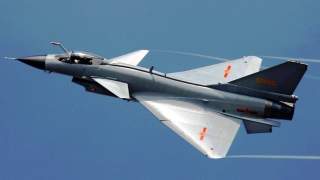Iran Would Love to Buy These 3 Fighter Jets from Russia and China
But it will almost certainly never happen.
Key Point: But how would America respond?
The Iranian air force on paper is one of the biggest air arms in the world. Its order of battle includes around 350 fighters, more than twice as many as the Royal Air Force possesses.
But most of Iran’s fighters are old and outdated. The ones that aren’t old are just new copies of old designs. The air force’s squadrons fly American-made F-14s, F-5s and F-4s dating from the 1970s, some 1980s-vintage MiG-29s and Sukhoi fighter-bombers and a few J-7s that the Islamic Republic bought from China during the 1990s.
Iran’s only recent acquisitions are locally-made, reverse-engineered copies of the F-5. But the country repeatedly has tried to buy new fighters, if all the news reports and rumors are true. What follows is a list of fighters Iran reportedly wanted but couldn’t get.
MiG-31:
In 1990 Tehran placed an order from Moscow for, among other weapons, 24 MiG-31 interceptors. The twin-engine MiG-31 was the Soviet Union’s successor to the Mach-three MiG-25. MiG-31s significantly could have improved Iran’s ability to patrol its air space and threaten its neighbors.
But the Soviet Union collapsed before it could fill Iran’s order. In 1992, Tehran tried again, ordering from a cash-hungry Russia a fresh batch of MiG-29s and well as Tu-22 bombers, MiG-27 fighter-bombers and 24 MiG-31s. This time around the United States successfully applied pressure on Russia to cancel the sale.
The United States reportedly even offered to buy the MiG-31s from Russia at a higher price than Iran could afford.
Nine years later in 2001, Tehran tried one more to acquire MiG-31s, and even paid for them in advance. Again, the United States leaned on Russia to cancel the contract.
Su-27/Su-30:
Reports abound of alleged Iranian attempts to acquire from Russia either Su-27 fighters or the more modern Su-30 version of the same plane. In 2007 rumors of a contract for a whopping 250 Su-30s compelled the head of Rosoboronexport, Russia’s arms-export agency, to formally deny that any such sale was in the works.
Iran in 2016 reportedly tried again the acquire the Su-30, but this time U.N. sanctions -- part of the 2015 deal limiting Iran’s nuclear program -- complicated the effort.
J-10:
Iran in the 1990s succeeded in buying a few J-7s from China. The J-7 is China’s copy of the Russian MiG-21. In the past decade the Chinese air force has begun replacing many of its own J-7s with newer J-10s. The J-10 is a much more modern design. Its performance roughly matches that of the American F-16.
In 2015 rumors circulated that Tehran wanted to acquire as many as 150 J-10s. But nothing came of the rumors. China, it’s worth noting, is a major trading partner with the Middle East’s Arab states such as Saudi Arabia and the United Arab Emirates, both bitter rivals of Persian Iran.
For China, selling a few billions dollars worth of warplanes to Iran probably isn’t worth the diplomatic rift with Arab governments that could result.
What Iran Does Instead:
Barred from acquiring new fighters, Iran has resorted to upgrading and copying its older planes. F-4s, F-14s and Su-22s have received structural repairs and new sensors and weapons. Meanwhile, Iranian engineers have torn apart, studied and copied the simple, lightweight F-5 and produced at least two kinds of clone.
The Saeqeh apparently mates the fuselage of an unflyable F-5 with new twin tail fins replacing the old, single fin. Iran reportedly has built nine Saeqehs since the type first appeared in 2004.
In 2018 Iran revealed another F-5 clone, the two-seat Kowsar. Iranian state media claimed the Kowsar is 100-percent locally-made, but as with the Saeqeh it’s possible that Iran is basing the “new” fighter on old, stored F-5 airframes rather than building airframes from scratch.
Frustrated for decades in its attempts to buy new fighters, Iran might have no choice but to endlessly upgrade old planes. But there are limits to what upgrades can achieve. An F-4 with a better radar is still an F-4: sluggish, hard-to-fly and decided non-stealthy.
Likewise, a copy of an F-5 still performs just like an F-5 does and probably could not match the more modern warplanes that Iran’s rivals operate.
David Axe serves as Defense Editor of the National Interest. He is the author of the graphic novels War Fix, War Is Boring and Machete Squad.

